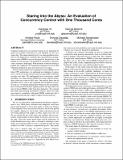| dc.contributor.author | Yu, Xiangyao | |
| dc.contributor.author | Bezerra, George | |
| dc.contributor.author | Pavlo, Andrew | |
| dc.contributor.author | Devadas, Srinivas | |
| dc.contributor.author | Stonebraker, Michael | |
| dc.date.accessioned | 2015-11-24T14:09:45Z | |
| dc.date.available | 2015-11-24T14:09:45Z | |
| dc.date.issued | 2014-11 | |
| dc.identifier.issn | 21508097 | |
| dc.identifier.uri | http://hdl.handle.net/1721.1/100022 | |
| dc.description.abstract | Computer architectures are moving towards an era dominated by many-core machines with dozens or even hundreds of cores on a single chip. This unprecedented level of on-chip parallelism introduces a new dimension to scalability that current database management systems (DBMSs) were not designed for. In particular, as the number of cores increases, the problem of concurrency control becomes extremely challenging. With hundreds of threads running in parallel, the complexity of coordinating competing accesses to data will likely diminish the gains from increased core counts.
To better understand just how unprepared current DBMSs are for future CPU architectures, we performed an evaluation of concurrency control for on-line transaction processing (OLTP) workloads on many-core chips. We implemented seven concurrency control algorithms on a main-memory DBMS and using computer simulations scaled our system to 1024 cores. Our analysis shows that all algorithms fail to scale to this magnitude but for different reasons. In each case, we identify fundamental bottlenecks that are independent of the particular database implementation and argue that even state-of-the-art DBMSs suffer from these limitations. We conclude that rather than pursuing incremental solutions, many-core chips may require a completely redesigned DBMS architecture that is built from ground up and is tightly coupled with the hardware. | en_US |
| dc.description.sponsorship | Intel Corporation (Science and Technology Center for Big Data) | en_US |
| dc.language.iso | en_US | |
| dc.publisher | Association for Computing Machinery (ACM) | en_US |
| dc.relation.isversionof | http://dx.doi.org/10.14778/2735508.2735511 | en_US |
| dc.rights | Creative Commons Attribution-Noncommercial-Share Alike | en_US |
| dc.rights.uri | http://creativecommons.org/licenses/by-nc-sa/4.0/ | en_US |
| dc.source | MIT web domain | en_US |
| dc.title | Staring into the abyss: An evaluation of concurrency control with one thousand cores | en_US |
| dc.type | Article | en_US |
| dc.identifier.citation | Yu, Xiangyao, George Bezerra, Andrew Pavlo, Srinivas Devadas, and Michael Stonebraker. “Staring into the Abyss.” Proceedings of the VLDB Endowment 8, no. 3 (November 1, 2014): 209–220. | en_US |
| dc.contributor.department | Massachusetts Institute of Technology. Computer Science and Artificial Intelligence Laboratory | en_US |
| dc.contributor.department | Massachusetts Institute of Technology. Department of Electrical Engineering and Computer Science | en_US |
| dc.contributor.mitauthor | Yu, Xiangyao | en_US |
| dc.contributor.mitauthor | Bezerra, George | en_US |
| dc.contributor.mitauthor | Devadas, Srinivas | en_US |
| dc.contributor.mitauthor | Stonebraker, Michael | en_US |
| dc.relation.journal | Proceedings of the VLDB Endowment | en_US |
| dc.eprint.version | Author's final manuscript | en_US |
| dc.type.uri | http://purl.org/eprint/type/ConferencePaper | en_US |
| eprint.status | http://purl.org/eprint/status/NonPeerReviewed | en_US |
| dspace.orderedauthors | Yu, Xiangyao; Bezerra, George; Pavlo, Andrew; Devadas, Srinivas; Stonebraker, Michael | en_US |
| dc.identifier.orcid | https://orcid.org/0000-0001-9184-9058 | |
| dc.identifier.orcid | https://orcid.org/0000-0001-8253-7714 | |
| dc.identifier.orcid | https://orcid.org/0000-0003-4317-3457 | |
| mit.license | OPEN_ACCESS_POLICY | en_US |
| mit.metadata.status | Complete | |
